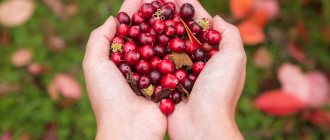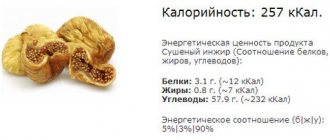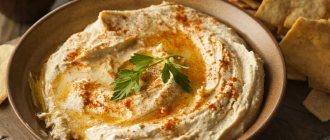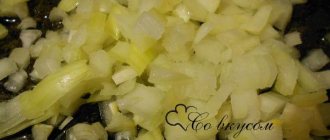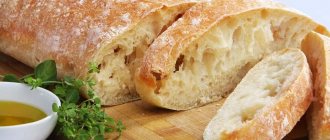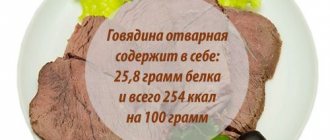Properties of basil
Nutritional value and composition | Vitamins | Minerals
How much does basil cost (average price for 1 kg)?
Moscow and Moscow region.
410 rub.
India is said to be the birthplace of basil. In addition to the name we are used to, this fragrant herb has several more names, including rean, reagan, and fragrant cornflower. If you believe history, he came to Europe with the soldiers of Alexander the Great. Currently, basil is cultivated as an agricultural crop in the CIS countries, the USA, China and India.
Basil is considered truly one of the most versatile herbs with an unsurpassed aroma, as it can be used either alone or in mixtures with other spices and herbs. It perfectly complements the composition of various sauces and simply decorates dishes. However, due to the fact that the aromatic properties of basil quickly disappear during heat treatment, it is recommended to add it to ready-made dishes or, in extreme cases, to hot ones a couple of minutes before they are ready. The calorie content of basil is low and equal to 23 kcal per 100 grams of greens.
Fresh basil serves as a seasoning for salads, meat and fish dishes, as well as poultry dishes. For pickling, not only the fresh herbs of this herb are used, but also the dried spice. It is simply impossible to imagine Mediterranean cuisine without this wonderful aromatic green or dark purple herb.
Application
It is impossible to imagine Italian, Georgian and other national cuisines without basil. It goes great with salads, soups, pizza, fresh vegetables and sauces. In the food industry, this spice is used for canning and smoking, and in the alcohol industry, for the production of liqueurs and cocktails. Adding a sprig of young herbs to vinegar can serve as a flavoring agent, and salads dressed with it acquire a piquant taste.
Market Analytics
- COVID-19 is changing the rules of the game in the cosmetics market
- Beauty of the future: cosmetic innovations 2020
- New ingredients are the driving force of the cosmetics industry
Convenient search for beauty salons on our website
Beauty salons in Moscow Beauty salons in St. Petersburg Beauty salons in Ekaterinburg Beauty salons in Novosibirsk
Latest blog posts on our website
- Naturecream / Geranium (Pelargonium) oil for skin health and beauty
- Prostye-sovety / Save on a beauty salon: procedures that can be done at home
- Naturecream / Growth Factor - brings back youth?
- Oksana-Lezina / 3 effective abdominal exercises from a fitness instructor for beginners
- Prostye-sovety / Making perfect curls at home
- Prostye-sovety / Which hair removal method to choose
- Naturecream / Wrinkles Puppets
- Naturecream / PEPHA-TIGHT - instant skin lifting
- Naturecream / Blue light - a danger to the skin
- Naturecream / Cocoa Butter – A treat for the skin
Latest forum topics on our website
- Mrs._Smith / Badly sunburned! What to do?((
- Ice / Is it necessary to combine fitness classes with a diet?
- Antonova / What can be used for hair loss?
- Radio operatorKat / Who was on a protein diet?
- Suzanna / Mesotherapy on the face
Other articles in this section
| Baking soda Baking soda (or otherwise scientifically known as sodium bicarbonate), whose chemical formula is NaHCO3, is a non-toxic crystalline substance, most often sold as a fine, odorless, salty powder (lye). As a result of chemical reactions, sodium carbonate salt precipitates, water is separated and carbon dioxide is released. The reaction is weak, therefore absolutely safe for humans, animals and plants. |
| Ketchup It is believed that ketchup was first prepared in China. And it first came to Europe only in the 17th century. Then it was little similar to the modern analogue of this sauce - it included mushrooms, beans, walnuts, garlic and wine. The main ingredient that now ranks first when making ketchup - tomatoes - was not part of the first ketchup made. In Europe, this sauce quickly took root and became widespread. The classic recipe for ketchup with tomatoes appeared only at the beginning of the 19th century in culinary notes and recipes of American housewives. |
| Cardamom This spicy seasoning has been known since ancient times. Cardamom was credited with healing properties. It was believed that it could relieve migraines, colds, and cure liver and intestinal diseases. Greek winemakers could not imagine drinks without cardamom grains. In the Middle Ages, the fruits began to be used for salting meat and fish. Until now, it is popular all over the world and in terms of sales - it ranks second after black pepper. |
| Cinnamon Cinnamon is a spice made from the dried bark of the evergreen tree of the same name. Its homeland is Sri Lanka; it is in this area that the best raw materials for the production of spices grow. It is also grown commercially in other countries with tropical climates. It goes on sale in the form of twisted sections of bark or in crushed form. It is considered more reliable to purchase non-powdered cinnamon, as foreign substances may be added during grinding. |
| Adjika Adjika is a spicy Caucasian seasoning in the form of a paste containing garlic, salt, red pepper and various herbs. It is often red in color, but can be green when using unripe peppers. According to one version, the word “adzhika” is translated from Abkhazian as “red salt”, according to another – as “bread with salt”. |
| Coriander Coriander is an annual herbaceous plant belonging to the Apiaceae family. Even the ancient Greeks treated it with great respect and considered it a medical remedy. Later, thanks to the Romans, coriander was discovered in England and Western Europe. Then he ended up in America and then in India. |
| Honey Honey is a natural product with unique properties. The appearance is thick, it is characterized by a viscous mass with pronounced taste and aroma qualities. The sweetness of honey is much higher than that of sugar and at the same time it is more velvety. The color of honey depends on which inflorescences the bees collected it from and the period of collection. The lighter the honey, the lower the concentration of minerals and trace elements. |
| Vanilla Vanilla is a spice that gives a unique taste to many confectionery products, nothing more than the fruits of one of the varieties of orchids. The plant from which vanilla is obtained grows in the tropical forests of South America. This is a vine with beautiful delicate flowers that bloom just one day a year. The fruits of the plant are collected before they are ripe, dried in a special way until a white coating forms on them, which gives us the familiar aroma of vanilla. |
| Bay leaf Bay leaf is a well-known seasoning, which is the dried leaves of the evergreen laurel shrub. Used in its original and crushed form. It has a characteristic aroma and slight bitterness. The plant's homeland is Asia Minor and the Balkan Peninsula, although laurel gained great popularity during the Roman Empire. For the Romans, bay leaf was not only a spicy addition when preparing dishes, but also a symbol. A crown of laurel branches personified glory, strength, and victory. |
| Zira Zira - seeds of the herb cumin, which belongs to the parsley family, is sold in the form of oblong-shaped grains. In many countries it is usually called by its Latin name; in our country it is called the same as in the East. This seasoning has been known since ancient times, but has gained great popularity in oriental cuisine for medicine. The history of the use of cumin goes back many centuries. It is often confused with caraway seeds, which are similar in appearance to cumin grains. Due to its specific taste, it is often used as a seasoning for bread and meat dishes. |
Benefits of basil
It perfectly tones, contributing to the overall strengthening of the body, so the benefits of basil are obvious during the recovery period after surgery. It can be used both externally and internally. To gargle for respiratory infections, a special infusion is prepared, which includes this medicinal plant. If you are worried about bad breath, gum disease or tooth decay, this medicine will also come to the rescue.
Having a mild diuretic effect, this natural remedy can soften small kidney stones and also remove excess uric acid. At the initial stage of development of urolithiasis, this is simply a wonderful natural medicine. By the way, regular consumption of basil generally has a beneficial effect on the normal functioning of the entire genitourinary system.
The benefits of basil are also justified in the treatment of headaches, neurotic heart pain, cough, rheumatism and a number of other diseases. Traditional medicine recommends using basil as a preventive anticancer agent.
Fresh basil - calories and nutritional value
Per 100 g of product*
*The average value of nutritional data from various sources is given. Depending on the origin of the product, it may differ from the actual one.
**Values are based on a diet based on 2000 kcal/day
BJU ratio*
Contains a large amount of protein with a low calorie content of the product.
*Optimal ratio of proteins, fats and carbohydrates (by weight): 16%, 17%, 67%.
Similar products
Recipes with this product
Mobile app
Download our free daily calorie counting app with built-in calorie chart!
Login to the diary
Description
Dried basil
even in this form it retains most of its beneficial properties, as well as its unique aroma.
Preparing such a homemade spice for the winter is not only possible, but necessary. Thanks to our simple step-by-step photo recipe, you will learn in detail about the correct technique for drying herbs and basil, including. In cooking, this product is primarily valued for its aroma and taste.
It is also a low-calorie product, so it is recommended by many nutritionists.
Basil prevents most viral and fungal infections and helps reduce body fat. At the same time, it has practically no contraindications, although it is not recommended to use it in large quantities. Fortunately, most often this plant is used only as a spice, so it cannot harm.
You need to dry fresh basil leaves using a certain method; you can’t just lay them on a towel and wait for everything to happen. Even a simple recipe has its own technique and sequence.
The use of dried basil depends only on your personal desires and preferences: you can, for example, create a wonderful aromatic sauce from it. Let's start preparing dried basil for the winter at home.
Royal herb basil - photo
Basil (translated from Greek as “royal”) has long been considered a royal herb. It is widely used in cooking, especially in Mediterranean countries, as a spice, adding to salads and soups. Characteristic notes of spicy cloves, a slightly tart taste of lemon, subtle notes of allspice give a unique taste to the dishes.
More than 40 aromas are found in nature. But the brightest notes are found in Genoese and Neapolitan basil.
In our country, the most common basils are purple, green, and lemon.
The purple variety looks beautiful in salads, and the aroma of the spice is more noticeable, it is even planted for beauty, green basil is also called fragrant, it is more used in Caucasian cuisine, the lemon variety is used more for flavoring desserts and drinks.
Use in cosmetology
The herbal remedy is used for beauty because it contains antioxidants, tannins and antibacterial components.
- For hair . The use of basil essential oil helps strengthen the roots, eliminate fragility and excess oiliness of the strands. To do this, add an ethereal extract to the shampoo, balm or mask at the rate of three to four drops per 10 g of the original product.
- For face . Basil extracts are used to create anti-aging products. Thanks to them, it is possible to significantly improve skin color, eliminate dullness, and make facial wrinkles less noticeable. Dermatoses, acne, pimples, and blackheads are treated with decoctions of the leaves.
It is best to start using basil for treatment with small doses. If an allergy occurs, consult a doctor.
Basil is not only a spice but also a medicinal plant well known for its healing properties in India.
Using dried basil in cooking
In all restaurants around the world, basil is used in the preparation of the most unusual and expensive dishes.
Just a pinch of this seasoning can work real miracles. It changes the taste of soups, meat, fish and vegetable dishes for the better; preserves and omelettes will also acquire an original piquant taste and unique aroma thanks to basil. This seasoning is also suitable for preparing dressings and sauces. It is often added when preparing alcoholic beverages.
Basil goes well with rosemary, tarragon, coriander and mint, so we recommend using a mixture of these spices when preparing your favorite dishes.

